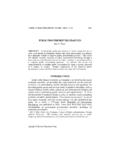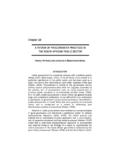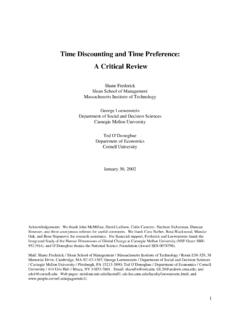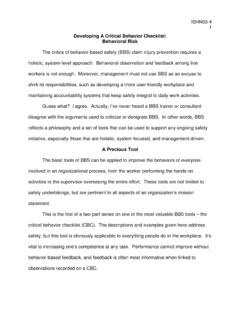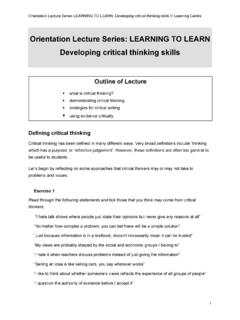Transcription of CRITICAL FACTORS THAT INFLUENCE E …
1 JOURNAL OF PUBLIC procurement , VOLUME 6, ISSUES 1 & 3, 70-99 2006 CRITICAL FACTORS that INFLUENCE E- procurement implementation SUCCESS IN THE PUBLIC SECTOR Kishor Vaidya, A. S. M. Sajeev and Guy Callender* ABSTRACT. This paper presents the results of a literature survey developed to support a proposed model of the CRITICAL Success FACTORS (CSFs) likely to impact the success of e- procurement initiatives in the public sector. It identifies a number of relevant variables for each CSF and presents a model for future research. It also analyses the relative importance of different CSFs and observes that organization and management FACTORS are the most important category for success of e- procurement initiatives.
2 If e- procurement initiatives in the public sector are to assist the development of e- procurement across the information economy, there should be wider discussion and agreement on what constitutes the relevant CSFs and how the achievement of success can be assessed. INTRODUCTION A number of public sector agencies worldwide have identified Electronic procurement (e- procurement ) as a priority e-Government agenda and have implemented or are in the process of implementing buy-side e- procurement systems. However, the scholarly evaluation of e- ------------------- * K.
3 Vaidya and Sajeev, , are Candidate and Professor and Chair of IT and Computer Science, respectively, School of Mathematics, Statistics and Computer Science, University of New England, Australia. Mr Vaidya s research interests are in the domains of adoption, implementation , performance measurement of e-Commerce innovations, and public procurement . Dr. Sajeev s research interests are in the areas of Software Engineering and Web Engineering. Dr. Callender is Foundation Professor and Chair of Leadership of Strategic procurement and, Editor-in-Chief of the Journal of Contemporary Issues in Business and Government, Curtin University of Technology, Australia.
4 His research interests are procurement , the supply chain, supply market intelligence, and commercial history. Copyright 2006 by PrAcademics Press CRITICAL FACTORS that INFLUENCE E- procurement implementation SUCCESS 71 procurement initiatives, especially in relation to the use of CRITICAL Success FACTORS (CSFs) in e- procurement is very limited (Birks, Bond & Radford, 2001; DOF, 2001; CGEC, 2002; ECOM, 2002). A review of e- procurement literature, primarily from the last five years, shows a lack of core constructs around CSFs. The reason for this might be that implementation of e- procurement initiatives in the public sector is still in the early stages.
5 Tonkin (2003) argues there was little history of extensive use of e- procurement in the public sector and, therefore, the academic literature covering early public sector adoption of e- procurement is limited. This paper will assess the CSFs that are likely to INFLUENCE the success of e- procurement initiatives in the public sector. The main overall objectives of the paper are to gain an exploratory understanding of e- procurement issues in the public sector; to develop a conceptual framework that aids in identification of CRITICAL success FACTORS for adopting and implementing e- procurement in the public sector; and to stimulate debate about the e- procurement CSFs and the associated measures for success.
6 Through a survey of the e- procurement literature, this paper identifies eleven FACTORS : end-user uptake and training, supplier adoption, compliance with best practices for business case/project management, systems integration, security and authentication, re-engineering the process, top management support, performance measurement, change management, e- procurement implementation strategy, and technological standards. In the following sections, this paper discusses the background, requirements, and the barriers to e- procurement implementation in the public sector.
7 Following the methodological approach, each CSF is discussed in detail and a research model is presented. Finally, an analysis of the relative importance of the CSFs is presented and the paper concluded with a discussion on the differences and similarities of e- procurement projects compared with traditional IT projects in the public sector. BACKGROUND What is e- procurement ? Confusion exists in defining the term e- procurement (Vaidya, Yu, Soar & Turner, 2003). While the terms e- procurement and e-Purchasing have been used synonymously in many jurisdictions in an attempt to prove their involvement in the e-Commerce revolution (MacManus, 2002), the term purchasing has a 72 VAIDYA, SAJEEV & CALLENDER narrower scope.
8 E- procurement refers to the use of Internet-based (integrated) information and communication technologies (ICTs) to carry out individual or all stages of the procurement process including search, sourcing, negotiation, ordering, receipt, and post-purchase review (Croom & Brandon-Jones, 2004). While there are various forms of e- procurement that concentrate on one or many stages of the procurement process such as e-Tendering, e-Marketplace, e-Auction/Reverse Auction, and e-Catalogue/Purchasing, e- procurement can be viewed more broadly as an end-to-end solution that integrates and streamlines many procurement processes throughout the organization.
9 Although the term end-to-end e- procurement is popular, industry and academic analysts indicate that this ideal model is rarely achieved (DOIR, 2001) and e- procurement implementations generally involve a mixture of different models (S&A, 2003). Although such end-to-end solutions offer robust and usually rich functionality, they are designed specifically to excel in just one or a few applications and thus pose various challenges (Cuthbert, Hamzic & Archer, 2003). Nevertheless, this paper will refer to the end-to-end e- procurement system in order to avoid confusion but will not consider general email, electronic fax, voice communications, or non-Internet/Web based approaches, which are regarded as partial traditional e- procurement solutions.
10 As one of the core enablers of an e-Business supply chain, e- procurement in this article is conceptualized as a subset of e-Commerce. While e-Commerce is simply a transaction conducted electronically, e- procurement is the automation of many procurement processes via electronic systems, especially the Internet. Having defined e- procurement for the purpose of this paper, it is also important to also define the term implementation . What is implementation ? As with e- procurement , implementation has been defined in different ways.
